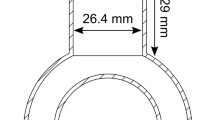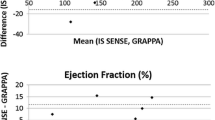Abstract
Clinical use of cardiac cine CT imaging is limited by high radiation dose and low temporal resolution. To evaluate a low radiation dose, high temporal resolution cardiac cine CT protocol in human cardiac CT and phantom scans. CT scans of a circulating iodine target were reconstructed using the conventional single heartbeat half-scan (HS, approx. 175 ms temporal resolution) and the 3-heartbeat multi-segment (MS, approx. 58 ms) algorithms. Motion artifacts were quantified by the root-mean-square error (RMSE). Low-dose cardiac cine CT scans were performed in 55 subjects at a tube potential of 80 kVp and current of 80 mA. Image quality of HS and MS scans was assessed by blinded reader quality assessment, left ventricular (LV) free wall motion, and LV ejection rate. Motion artifacts in phantom scans were higher in HS than in MS reconstructions (RSME 188 and 117 HU, respectively; p = 0.001). Median radiation dose in human scans was 1.2 mSv. LV late diastolic filling was observed more frequently in MS than in HS images (42 vs. 26 subjects, respectively; p < 0.001). LV free wall systolic motion was more physiologic and had less error in MS than in HS reconstructions (sum-of-squared errors 34 vs. 45 mm2, respectively; p < 0.001), and LV peak ejection rate was higher in MS than in HS reconstructions (166 vs. 152 mL/s, respectively; p < 0.001). Cardiac cine CT imaging is feasible at a low radiation dose of 1.2 mSv. MS reconstruction showed improved imaging of rapid motion in phantom studies and human cardiac CTs.



Similar content being viewed by others
Data availability
Not available due to privacy concerns.
References
Amzulescu MS, De Craene M, Langet H, Pasquet A, Vancraeynest D, Pouleur AC, Vanoverschelde JL, Gerber BL (2019) Myocardial strain imaging: review of general principles, validation, and sources of discrepancies. Eur Hear J Cardiovasc Imaging 20:605–619. https://doi.org/10.1093/ehjci/jez041
Krishnamurthy R, Pednekar A, Cheong B, Muthupillai R (2010) High temporal resolution SSFP cine MRI for estimation of left ventricular diastolic parameters. J Magn Reson Imaging 31:872–880. https://doi.org/10.1002/jmri.22123
Zhu M, Streiff C, Panosian J, Zhang Z, Song X, Sahn DJ, Ashraf M (2015) Regional strain determination and myocardial infarction detection by three-dimensional echocardiography with varied temporal resolution. Echocardiography 32:339–348. https://doi.org/10.1111/echo.12632
Behar JM, Rajani R, Pourmorteza A, Preston R, Razeghi O, Niederer S, Adhya S, Claridge S, Jackson T, Sieniewicz B, Gould J, Carr-White G, Razavi R, McVeigh E, Rinaldi CA (2017) Comprehensive use of cardiac computed tomography to guide left ventricular lead placement in cardiac resynchronization therapy. Heart Rhythm 14:1364–1372. https://doi.org/10.1016/j.hrthm.2017.04.041
Tee MW, Won S, Raman FS, Yi C, Vigneault DM, Davies-Venn C, Liu S, Lardo AC, Lima JAC, Noble JA, Emter CA, Bluemke DA (2015) Regional strain analysis with multidetector CT in a swine cardiomyopathy model: relationship to cardiac MR tagging and myocardial fibrosis. Radiology 277:88–94. https://doi.org/10.1148/radiol.2015142339
Han BK, Hlavacek AM, Kay WA, Pham TDN, Grant K, Garberich RF, Lesser JR, Raman SV (2016) Multi-institutional evaluation of the indications and radiation dose of functional cardiovascular computed tomography (CCT) imaging in congenital heart disease. Int J Cardiovasc Imaging 32:339–346. https://doi.org/10.1007/s10554-015-0775-y
Pasricha SS, Nandurkar D, Seneviratne SK, Cameron JD, Crossett M, Schneider-Kolsky ME, Troupis JM (2009) Image quality of coronary 320-MDCT in patients with atrial fibrillation: initial experience. Am J Roentgenol 193:1514–1521. https://doi.org/10.2214/AJR.09.2319
Einstein AJ, Elliston CD, Arai AE, Chen MY, Mather R, Pearson GDN, DeLaPaz RL, Nickoloff E, Dutta A, Brenner DJ (2010) Radiation dose from single-heartbeat coronary CT angiography performed with a 320–detector row volume scanner. Radiology 254:698–706. https://doi.org/10.1148/radiol.09090779
Hausleiter J, Meyer T, Hadamitzky M, Huber E, Zankl M, Martinoff S, Kastrati A, Schömig A (2006) Radiation dose estimates from cardiac multislice computed tomography in daily practice. Circulation 113:1305–1310. https://doi.org/10.1161/CIRCULATIONAHA.105.602490
van der Wall EE, de Graaf FR, van Velzen JE, Jukema JW, Schuijf JD, Bax JJ (2011) Functional analysis by 64-slice CT scanning: prediction of left ventricular dysfunction together with reduction in radiation exposure? Int J Cardiovasc Imaging 27:1089–1093. https://doi.org/10.1007/s10554-010-9771-4
Groves DW, Olivieri LJ, Shanbhag SM, Bronson KC, Yu JH, Nelson EA, Rollison SF, Stagliano MS, John AS, Kuehl K, Chen MY (2017) Feasibility of low radiation dose retrospectively-gated cardiac CT for functional analysis in adult congenital heart disease. Int J Cardiol 228:180–183. https://doi.org/10.1016/j.ijcard.2016.11.108
Lesser AM, Newell MC, Samara MA, Gornick C, Grant K, Garberich R, Han BK (2016) Radiation dose and image quality of 70 kVp functional cardiovascular computed tomography imaging in congenital heart disease. J Cardiovasc Comput Tomogr 10:173–178. https://doi.org/10.1016/j.jcct.2015.12.009
Achenbach S, Ropers D, Holle J, Muschiol G, Daniel WG, Moshage W (2000) In-plane coronary arterial motion velocity: measurement with electron-beam CT. Radiology 216:457–463. https://doi.org/10.1148/radiology.216.2.r00au19457
IRCP (2007) Preface, executive summary and glossary. Ann ICRP 37:9–34. https://doi.org/10.1016/j.icrp.2007.10.003
Schneider CA, Rasband WS, Eliceiri KW (2012) NIH Image to ImageJ: 25 years of image analysis. Nat Methods 9:671–675
Li J, Denney TS (2006) Left ventricular motion reconstruction with a prolate spheroidal B-spline model. Phys Med Biol 51:517–537. https://doi.org/10.1088/0031-9155/51/3/004
Ozturk C, McVeigh ER (2000) Four-dimensional B-spline based motion analysis of tagged MR images: introduction and in vivo validation. Phys Med Biol 45:1683–1702. https://doi.org/10.1088/0031-9155/45/6/319
Negoita M, Zolgharni M, Dadkho E, Pernigo M, Mielewczik M, Cole GD, Dhutia NM, Francis DP (2016) Frame rate required for speckle tracking echocardiography: A quantitative clinical study with open-source, vendor-independent software. Int J Cardiol 218:31–36. https://doi.org/10.1016/j.ijcard.2016.05.047
Kawel-Boehm N, Maceira A, Valsangiacomo-Buechel ER, Vogel-Claussen J, Turkbey EB, Williams R, Plein S, Tee M, Eng J, Bluemke DA (2015) Normal values for cardiovascular magnetic resonance in adults and children. J Cardiovasc Magn Reson 17:29. https://doi.org/10.1186/s12968-015-0111-7
Smiseth OA, Torp H, Opdahl A, Haugaa KH, Urheim S (1207b) Myocardial strain imaging: how useful is it in clinical decision making? Eur Heart J 37:1196–1207b
Acknowledgements
We thank Rolf Symons, currently at the University Hospitals Leuven, for his constructive feedback on the manuscript and Amir Pourmorteza, currently at Emory University, for his critical review of the manuscript.
Funding
Intramural NIH program.
Author information
Authors and Affiliations
Corresponding author
Ethics declarations
Conflicts of interest
The authors declare that they have no conflict of interest.
Ethics approval
NIH IRB approval.
Additional information
Publisher's Note
Springer Nature remains neutral with regard to jurisdictional claims in published maps and institutional affiliations.
Electronic supplementary material
Below is the link to the electronic supplementary material.
10554_2020_1863_MOESM1_ESM.tif
Supplemental figure 1. Schematic images of an iodine-filled 50 mL conical tube (left) fixed in the center of an orbital shaker (right). (TIF 6938 kb)
Rights and permissions
About this article
Cite this article
Choi, Y.J., Ahlman, M.A., Mallek, M. et al. Cardiac cine CT approaching 1 mSv: implementation and assessment of a 58-ms temporal resolution protocol. Int J Cardiovasc Imaging 36, 1583–1591 (2020). https://doi.org/10.1007/s10554-020-01863-z
Received:
Accepted:
Published:
Issue Date:
DOI: https://doi.org/10.1007/s10554-020-01863-z




